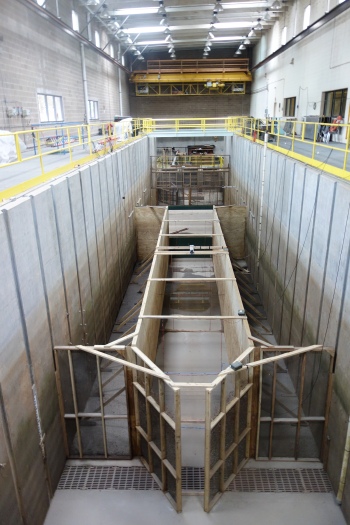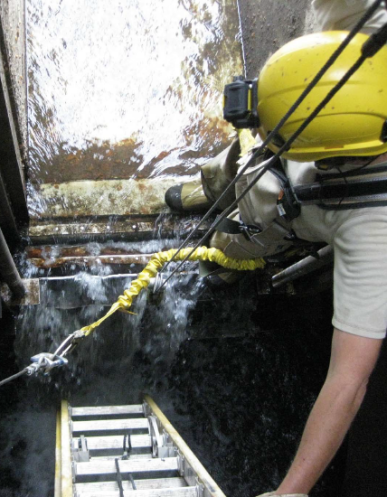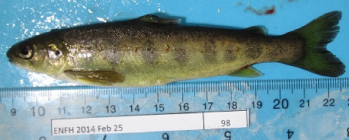This is the fourth feature in a five-part series that follows an Atlantic salmon on its journey upstream to spawn in a tributary of Lake Champlain driven by its instincts (and a pickup truck). Learn why this species disappeared from the lake in the 19th century, and how it is making a comeback today thanks to collaboration by partners in the basin.
“I want you to see this structure out here because it has really informed our thinking about the effects of barriers on fish movement,” said U.S. Geological Survey Research Ecologist Theodore Castro-Santos as we walked across the snow-covered grounds of the Silvio O. Conte Anadromous Fish Research Center in Turners Falls, Mass., to check out what appeared to be a swimming pool connected to a long cylinder wrapped in plastic.
“This is the Aquatic Biomechanics and Kinematic Research Station. We call it ABiKiS.”

USGS Research Ecologist Theodore Castro-Santos with ABiKiS, one of several structures used by scientists at the Silvio O. Conte Anadromous Fish Research Center to learn how fish respond to barriers.
Although ABiKiS was battened down for the winter, Castro-Santos helped me picture what it would look like in action. “Imagine this is something like a culvert,” he said of the cylinder. “We introduce fish into the tank, feed in lots of water, and then drive flows through the system at different velocities.”
Then they just wait, and watch. For what? Initially, the researchers intended to use ABiKiS to study the biomechanics of swimming — how fish move — to figure out how to design structures that would be easier for them to navigate. But something else caught their attention during the trials. Regardless of their swimming ability, it took some fish much longer to enter the culvert than others. That is, if they entered at all. “We realized that when designing these structures, we had to consider motivation: Not just what can fish do, but what do fish do?”
This evolving understanding of fish behavior and physiology is helping partners advance a long-term goal for salmon restoration in the Lake Champlain Basin. “We are reemphasizing the recolonization of rivers by natural populations in all of our management decisions,” said Bill Ardren, Senior Fish Biologist for the Lake Champlain Fish and Wildlife Conservation Office.

This flexible facility at the Conte Anadromous Fish Research Station in Turners Fall, Mass., allows researchers to study how fish respond, or don’t respond, to different passage scenarios.
As such, the research in Turners Falls using ABiKiS and several other structures has offered valuable perspective on the conditions salmon need to succeed in Lake Champlain. Castro-Santos worked with graduate student Daniel Nyqvist from Karlstad University in Sweden to apply the movement theory informed by simulations to a real problem with downstream passage in the Winooski River in Vermont.
While adult salmon migrating up the Winooski to reproduce in the fall have had assistance reaching spawning habitat thanks to the collaborative “Trap and Truck” program, it appears juvenile salmon attempting to migrate out to the lake in the spring are not getting the help they need to navigate the series of three dams on the river.
“One third of the fish in our study failed to pass the first dam they encounter going downstream from their spawning areas — Essex 19 — and those that did pass spent weeks trying,” said Castro-Santos. Why? In part, they lacked motivation — literally, a reason to move.
“If you put a dam across a river, it stops the flow of current, and fish no longer have the natural cue to keep swimming,” he explained. More than just an inconvenience, this loss of momentum can be life changing. When a migratory fish encounters a barrier that it cannot pass safely, it will actually lose the physiological mechanisms that compel it to swim downstream in the first place. In other words, said Castro-Santos, “They stop being migrants.”

Hydraulic Engineer Brett Towler inspects the bypass at the Essex 19 dam after research indicated fish were having difficulties navigating the fishway.
Or, they get eaten by a predator that takes advantage of the salmon bottleneck. Either way, not what the salmon had in mind. Or the scientists.
“What we found following Ted’s study was that there were a number fish-passage issues with the existing facility,” said Brett Towler, a Hydraulic Engineer for the Service who crawled inside the dam’s intake area in the wake of the findings to take a closer look at the bypass. Towler provided the operator Green Mountain Power with recommendations for improvement, and the company is currently considering implementing some or all of them to help them achieve Low Impact Hydropower Certification for the dam.
To be fair, Towler pointed out that the problem has only surfaced because the salmon restoration program is seeing such strong returns. But that’s all the more reason to redouble fish passage efforts on the Winooski and other rivers. “The ability for smolts to migrate out is incredibly important to the natural life cycle of salmon.”
And enabling salmon to complete their natural life cycles is incredibly important for all aspects of a program focused on recolonization. Including in hatcheries. Ardren said that about six years ago, program managers started to wonder: “Would small changes in the way the fish were cultured increase the numbers that returned to rivers on their own?”
They decided to experiment with switching the water supply for half of the raceways at the Dwight D. Eisenhower National Fish Hatchery from well water to water from nearby Furnace Brook.

All of the salmon at the Dwight D. Eisenhower National Fish Hatchery are now raised in water supplied by Furnace Brook, rather than in well water.
While the well-water raised salmon, which were kept a comfortable 50 degrees Fahrenheit, continued to eat and grow throughout the winter, the brook-water raised salmon were literally frozen in time. “They were stuck at the size they had been in the fall,” said Ardren, explaining that in the dead of winter, Furnace Brook is a relatively “low energy” system. “Bridget, you could play hockey on it.”
After one year, all of the fish, big and small, were stocked in the Boquet and Winooski Rivers at the “smolt” stage, when salmon naturally want to swim downstream into the lake, to feed.


Salmon at the parr stage (top), compared with salmon at the smolt stage (bottom), when they experience the physiological changes that cue them to swim downstream.
After three years, when the experimental program ended, Ardren said, “We were surprised to find that the return rate of fish raised in brook water was three to five times higher than the return rate of fish raised in well water, even though the well-water raised fish were much larger when released.”
Scientists believe the smolt stage is also when imprinting occurs, enabling salmon to find their way back to their natal streams years later when it’s time to spawn. In a river, the bacteria and biofilms on rocks give off chemical cues that a salmon can key into. In well water, there’s no biofilm to speak of, which is good for drinking, but not so much for imprinting.
It seems fish that grow up in a more natural brook-water environment head out into the wild with their olfactory senses calibrated to recognize a river so they know where to go when nature calls. The finding was so strong, that now all of the fish at Eisenhower are raised in water from Furnace Brook, including my fish. She was stocked as a smolt in the Boquet River primed to imprint, and sure enough, found her way back there when it was time to reproduce. My fish may have needed a ride to get to the spawning grounds, but she didn’t need directions.
With each new finding, scientists are developing a better picture of the salmon life cycle, but there’s still the big picture. No matter how much we know about the cues that nature gives salmon to swim downstream to feed, or upstream to spawn, the long-term success of the salmon in the lake and its tributaries depends upon what happens on the surrounding landscape.
During my visit to the fish research station in Turners Falls, Castro-Santos made an observation about the shift in conservation priorities from individual species, to entire systems: “People often think about salmon when they think about fishways and fish passage, but the focus is now moving toward passing entire communities, not just salmon.”
I know he meant aquatic communities, but metaphorically, the idea goes beyond the river. My salmon passed a major obstacle in the Boquet thanks to partners who care about its future. In order for my salmon’s offspring to have a future in Lake Champlain, the restoration program has to address barriers for communities too.
And it is. Learn how next week, in the final installment.

Reblogged this on Gin Clear and commented:
Some more great research and “lessons learned” about restoring Atlantic salmon stocks.
Pingback: Driven by instincts and a pickup truck: An Atlantic salmon’s journey towards recovery | U.S. Fish and Wildlife Service Northeast Region
Pingback: Joining forces in the upstream battle for salmon | U.S. Fish and Wildlife Service Northeast Region
Pingback: Hatching a plan to save salmon | U.S. Fish and Wildlife Service Northeast Region